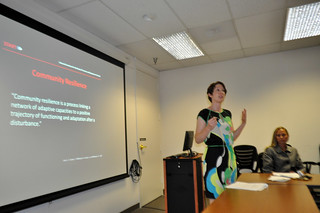Recently, START staff and interns convened to learn more about the methodology and policy implications of the Training in Risk and Crisis Communication Project (TRACC). Two of the project's researchers, Stephanie Madden and Elizabeth Petrun, led a START Research Roundtable titled "An Introduction to Risk Communication: Highlights from START's Training in Risk and Crisis Communication" recently at START headquarters, discussing all the facets of the project.
In developing a rigorous, scientifically informed risk communication training program, the team began the project by summarizing risk communication theory and best practices into reports that documented existing knowledge and knowledge gaps in risk communication research. Both reports were among START's most downloaded reports in 2012, with more than 18,500 downloads each. 
In addition to the literature reviews, the methodology also included a workshop with 26 academic and practitioner experts to discuss the greatest training needs. A needs assessment survey for current practitioners was also employed to determine what training practitioners typically receive and what they would like to receive.
Finally, to thoroughly document current training programs, Madden analyzed 173 existing English-language risk communication training programs to assess what types of training were and were not currently available.
"We followed a lengthy and very detailed process to develop this curriculum," Madden said. "We wanted to make sure we had the best training out there."
The team's report on survey findings and existing trainings revealed that what practitioners needed and what current trainings offered often diverged, revealing shortcomings in available education options.
For example, though the majority of respondents said they communicated about risks across all event phases (95 percent during the preparedness phase, 88.6 percent during response and 77.7 percent during recovery) only 15.3 percent of trainings cover all of those phases.
Other gaps emerged regarding few hazard-specific trainings and relative inattention to social media use, special needs populations and communication evaluation.
"Crisis communication is something that is not talked about enough, and I really appreciate TRACC's effort to bring scholarly research to teaching people about it," said Eliot Calhoun, a START GTD weapons and tactics project intern.
START CBRN project intern Caitlin Scuderi also found the methodology intriguing, saying "I thought it was really interesting how, by engaging with experts, you can build a theory and a project that can help inform a national dialogue."
The researchers hope to demonstrate the impact of their work through pilot testing of their training program, beginning with their June pilot. The two-day program guided participants through three of the course's modules. Ending with the crisis communication simulation, participants navigated their way through a fast-paced, realistic and complex terrorist attack scenario. Participants engaged with simulated traditional and social media, other teams representing responding agencies, and eventually course instructors who role-played journalists during a mock press conference.
Looking ahead, Petrun says her team, including Madden, Katherine Worboys Izsak and Brooke Fisher Liu, would like to revise the training materials based on feedback from their pilot program, including adapting the materials to different audiences.
"What you hope happens is that you're better off than where you started with the training," she said.
"The small gains that come from improved risk communication could have a lot of meaning. It could mean saving 100 people's lives, it could mean saving $100 million, it could mean saving a city."
